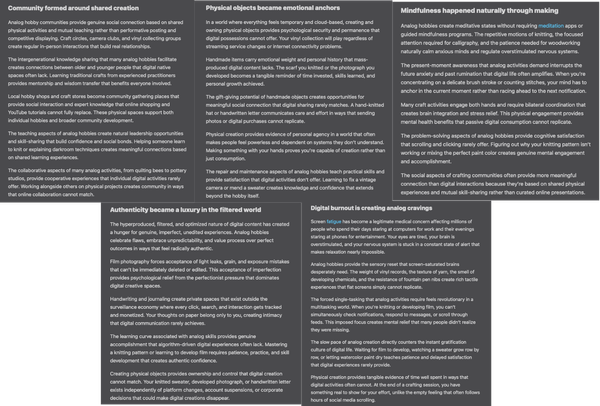A love note to [closed] captions
And misheard Seal lyrics
Notes from Jenn:
- Happy Mid-Autumn Festival! I had all the aspirations to make mooncakes this past weekend, but forces were working against me. I have all of the ingredients on hand, including the elusive ube, so I’m going to get them done this weekend!
- I’m still doing my morning pages though just on workday mornings. I finished yet another Moleskine journal in about a month and am now concerned about how I’m going to store all these journals if I continue down this route.
Published: Embracing Neurodiversity In The Modern Cafe
But some cafes take a different, more focused route when it comes to neurodivergent workers, and across the United States there is a growing cadre of cafes created specifically with neurodivergent workers in mind. Some are independent businesses; others are attached to nonprofit organizations. All of them have actionable insights to share, but no strategy is one-size-fits-all on a topic as broad and wide-reaching as this one.

A love note to captions
I love captions. They’ve been present my entire life. I have them on for everything I watch: TV shows, movies, YouTube videos, and IG videos.
As a kid, I used to find them a tad annoying. Sometimes, they blocked parts of the screen that I thought I wanted to see. Other times, I found myself reading instead of watching what was happening. But more important than these two items was that the captions helped my parents understand fast-spoken English. Though, seeing the words and being able to read them is entirely different from understanding them. Movies were often paused while my brother and I explained phrases and words.
Now, I appreciate them because they enhance my enjoyment and understanding of media. I’ve never been good at audio learning (I remain steadfast in this despite just learning that learning styles are a myth). I have trouble understanding accents of all kinds—this is true for me in both English and Mandarin—which means I’m slower to understand any dialogue that includes an accent. Captions help me learn word pronunciations, keep track of character names for me, and inform me about scenes I might’ve missed. On YouTube videos, I’m set at 1.5-2x playback speed, and with captions enabled, I can quickly read through whatever they’re saying.
I learn the majority of my vocabulary through reading. Growing up in a non-English-speaking household meant that the only exposure I had to word pronunciations was through media or school. My brother and I were also de facto pronunciation experts for my parents.

Related is reading lyrics for the first time for a familiar song. The first instance I remember this happening to me was Seal’s “Kiss from a Rose.” In undergrad, it was a favorite song in my friend group to belt out in the dorms.
And it was only then that I learned that the real lyrics are:
“To me, you're like a growing addiction that I can't deny”
When I’d been singing along to it for two decades:
“To me, you’re like a rolling dictionary that I can’t deny”
You might be wondering, why did you think that would even make sense? Well, let me explain. First, I loved reading and would have my dictionary on hand to look up words. Second, my parents made me go down the letters, stop at every word I didn’t know, and memorize their meanings. This stopped in 6th grade when my vocabulary learning source changed to the top hundred or so of SAT words. So, I thought, yeah, it makes sense that someone might roll a dictionary down a hill. And you can’t deny that while it’s happening. A little weird for an analogy, but I can see it. Maybe Seal also enjoys having a dictionary close by.
Had I watched the “Kiss from a Rose” music video back then with captions on, I might’ve known the actual lyrics. But then again, I didn’t have access to MTV. Everyone I’ve told this story to now confesses to me that they can’t unhear it and subsequently forgot the actual lyrics. So, I guess—you’re welcome.

Implementing captions is so much easier these days. Auto-captioning exists as a feature on many platforms. On Instagram, it’s a sticker; on YouTube, it’s a menu item. My biggest pet peeve is the number of people who film videos with necessary sounds—like talking to the camera or filming others having a dialogue—and not taking a second to add the IG sticker for auto-captions. It’s not a big ask. You’re not even transcribing anything. This tiny amount of work can make a huge difference to someone. In 2019, Verizon Media and Publicis Media conducted a study on captions and viewers’ habits. They found that 80% of people who use captions aren’t deaf or hard of hearing and that one in three has captions on in a public setting. I imagine that once someone conducts these kinds of studies again, but with TikTok included, the results might change.

There are many reasons one should put captions on a video. But if you really need data to convince you:
- Captions positively impacted ad performance on mobile with a 10% lift in ad memory quality and a 13% lift in brand linkage.
- Closed captions improve your SEO: “On average, a new video of ours gets about 450 views, but if it’s picked up by YouTube or Google search, it gets 10x the views.”
- Instapaper’s own A/B test found that video reactions were 17% higher on captioned videos and that CTA clicks fell by 26% when captions were removed.
After watching media with captions for so long, I feel a little lost when they’re off. I lose track of the plot, miss some important detail, or find myself straining to listen actively. Captions, I love you, and I’m glad you exist.

🤳🏻 social media
Instagram is testing a media kit development option for creators, end-to-end encryption in IG DMs, “add topics” to Reels, paid add-on subscriptions, and a repost feature. And thankfully ended its full-screen tests.
Google released a new process for creating a 3D image from 2D called LOLNeRF (not a joke). Twitter’s shareholders approved Musk’s acquisition though this all still has to go to trial. The network released a report on users’ news consumption (“75% of people who come to Twitter for news follow news about politics and current events on Twitter.”)
📤 digital marketing
- New Report Highlights Evolving Emoji Usage, and Opportunities for Brands: Adobe's latest emoji usage survey provides some interesting considerations for brand use.
- Social Media Customer Service Pitfalls and How to Avoid Them: [A comprehensive piece on how CS can go wrong.]
👀 interesting reads
- Confession: I write for a living, but I can’t pronounce any words: [An essay from someone who has a wide vocabulary learned through reading but has trouble pronouncing those words.]
- Can we finally kill off cheap, disposable conference swag?: The pandemic slowed down the $64 billion swag industry. Conferences are back, but do the cheap water bottles and stress balls need to come back with them?
- On Selling a Lifestyle: [Alicia Kennedy reflects on food writing and content creation.]






